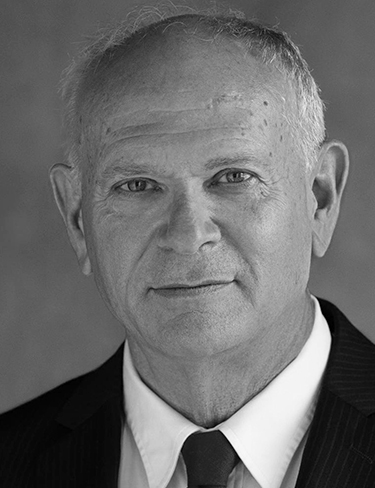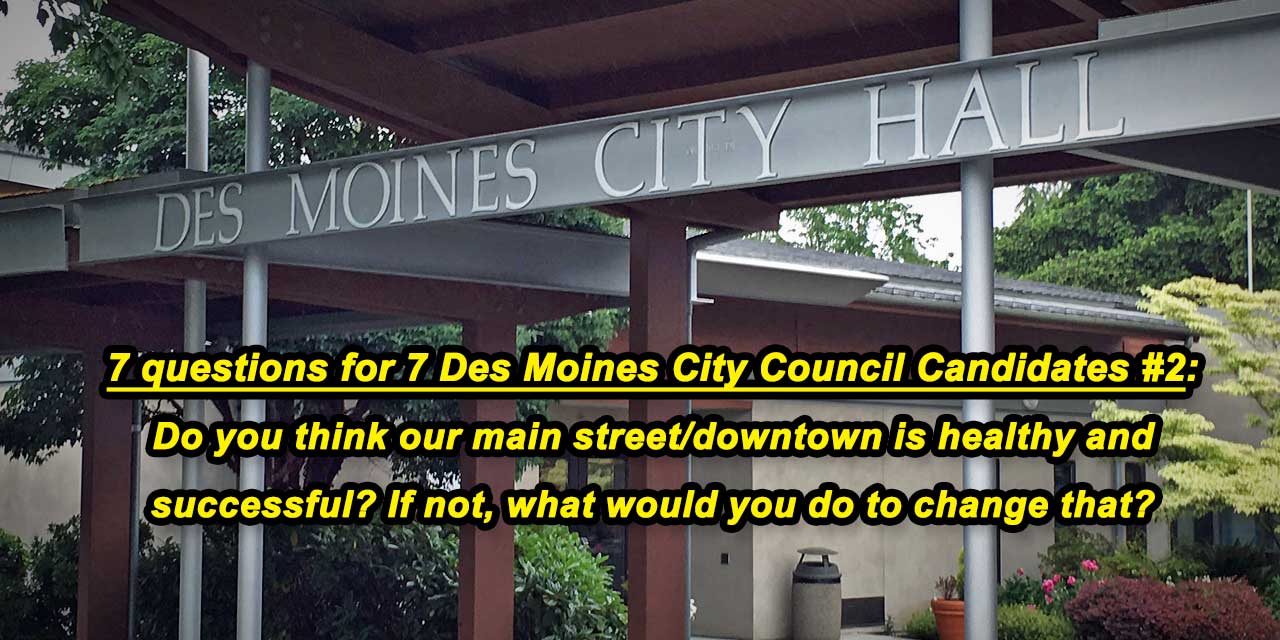By Scott Schaefer
Founder/Publisher/Editor
Ballots have been mailed, forums have been held, campaign signs are out and voters are deciding on seven local candidates on the ballot for four positions on the Des Moines City Council for the Nov. 2, 2021 General Election.
The Waterland Blog sent out seven questions to the seven candidates, and today we’re presenting their answers to the second one, in order of position numbers and names (and photos) as listed on the King County Elections website. Each candidate’s name also links to their statements on the Elections website.
Here’s question #2:
Do you think our main street/downtown is healthy and successful?
If not, what would you do to change that?
Positon No. 1

Harry Steinmetz
I don’t think downtown is healthy and successful as it could be. We have a lot to do to encourage development and reinvigorate it. We need to develop a comprehensive plan, that includes input from the current business owners, that creates a comprehensive look and feel to downtown.
Further, we need to look at making Marine View Drive and 7th Avenue one way streets, in opposite directions. The opportunity to make 7th Avenue as viable as Marine View Drive doubles the opportunities in our city.
Additionally, we need to use code enforcement to persuade owners, who are simply land banking, to make it less feasible to sit on their property until the price increases to the point where they want to sell. The empty lots need to be kept clean and garbage free.
Position No. 3

Gene Achziger
I don’t think our main street/downtown is healthy and prosperous, and again, I believe it is the passive vs. active problem. There is a general consensus that the Marina District is unhealthy, but no one fosters collaboration.
You have volunteer groups such as Destination Des Moines and Rotary trying to rally support for events, which is laudable. But where is the support? The City seems to find an obstruction to toss into every proposal.
Try and get a building permit, and people from one end of town to the other say it is frustrating. We have property owners content to sit on their assets and do nothing. Where is the City leadership to bring people together to form the consensus to break things loose?
Everyone looks to Leavenworth and its Bavarian Village theme as a shining model of saving a dying town. But what they don’t look at is the history. Several previous attempts failed because businesses saw the need (passive) but weren’t willing to throw into the plans.
Our City government needs to take a leadership role in bringing the businesses and property owners together. It needs to listen to what they are willing to do, rather than repeatedly telling them what to do.
Consensus building is complex, but to be successful, it must be an active process. The way we’ve been going about this is the definition of insanity. Same approach, same result. Let’s get active about bringing people together.

Priscilla Vargas
While the city of Des Moines is attempting to rebound from the negative economic impacts of the pandemic, our state and nation’s businesses have also suffered as well.
However, the City Manager and City Council have made a concerted effort to revitalize downtown businesses in conjunction with the economic development of the Marina. For example, as the Marina is developed new businesses will attract tourists, shoppers, commuters, restaurant, and entertainment patrons, thereby becoming a regional destination. In the interim, the City has provided grant funding for small businesses who qualify and is attempting to streamline the permitting process as well as examining current property zoning along with working extensively with contractors and investors to bring new businesses to Des Moines.
As development of the Marina and revitalization of our downtown businesses are two of my top priorities, I will work proactively with the city council and City Manager to provide the necessary support and leadership to accomplish these priorities!
Position No. 5

Traci Buxton
Our main street downtown is a good work in progress.
I believe it is important to continue to encourage our existing businesses,incentivize storefront and signage upgrades, facilitate business community connections with each other, and support business development services (e.g. our Highline College HBDC partnership).
We could also explore some code amendments for vacant land and storefronts, that would incentivize development and leasing.
In addition, I believe it is important to invest in local and regional outreach and messaging that promote our downtown as a dynamic, central location with a close, residential population; while also providing a contact person for the connections we generate.

Tad Doviak
Yes and no. Our main street has gone through a lot of changes over the recent years. There are good signs, like the theater construction and businesses that have been there for many years. The small business startups that are going in are also a positive sign. The negative signs are the vacant lots and businesses and the turnover that continues to happen. Good businesses move in and get no support from the landlords who in turn get little support from the city. While the city can’t just give its services away as it sees fit, it can pick and choose areas to help support our businesses and build a cohesive downtown area. I proposed this idea to the City Council a few years ago. Let’s create cohesive signage in the downtown core. Businesses can pick from 2-3 sign styles. The city will waive the sign permit fee for existing businesses for one year and for every new business that starts up. Businesses not in compliance with the cohesive signage will face a fine. Businesses that need extra time to purchase a sign can work with the city to get that extra time. Perhaps a Chamber of Commerce could help with funding for some businesses that need that extra boost up. The business sign permit fee is one of the reasons why there are banners hanging on store fronts everywhere; $170 for non-electrical and $450 for electrical. If there are lights, it’s electrical. Let’s do this one simple thing to make Des Moines really stand out in our community.
Position No. 7

Matt Mahoney
Downtown is something in need of new development. A glimpse is what we currently see in process at the Theatre. But we must all understand what we can change and what we can’t with privately owned properties. We can encourage a vision for our town, a look and feel, that sets a forward direction but holds a bit of that small town feel and that is why the development of the marina is so important. Real developers and investors are looking for amenities like our marina will provide and they will compliment and add value to their projects. This makes us attractive and helps set the stage to entice new construction, new business, more restaurants and maybe even a grocery store. In addition, we will bring a modern look and feel, livability and vibrancy downtown.

Soleil Lewis
I believe our downtown area of Des Moines is beautiful. Yet, it reflects a substantive lack of a healthy or thriving downtown reflective of sales tax revenue.
According to the Washington State DOR distribution results for September 2020, In September 2020, the amount of sales tax revenue generated was at $254,103.28, our current sales tax revenue has generated only $38,682.54 dollars more in comparison to September 2021 at $292,785.82.
Interesting, if only $38,682.54 was gained in a year, how healthy is our city?
Let’s compare this to a city with a similar population size such as: Seatac, Seatac has a population size of
29,044 people that is 3,304 less people than Des Moines at 32,348 as reported in the 2019 Census reports.
During September 2020, Seatac generated $940,867.60, they accrued $474,411.53 dollars more in September 2021 totaling out to $1,415,278.53.
Wow, think about that, during a pandemic a neighboring city with similar population size could make up $474,411.53 in sales tax revenue in comparison to us at only $40,000.
I’ve talked to numerous community members who desire downtown Des Moines to be redeveloped to reflect a thriving community. Think about this: Why is it that I speak to people who’ve resided in Des Moines for 30 years who share the same concerns about a lack of business development downtown. The revenue distribution reflects that our downtown businesses are not being supported to bring in customers, to generate significant tax revenue.
The community desires to have businesses that speak to the unique needs of they’re community. When you have 70% of your total population of 32,348 (Census report, 2019) who are not willing to consistently spend money downtown. Only 21% of that total population will shop downtown. 21% is reflective of concerns from the community that businesses downtown are not aesthetically drawing in customers. Especially since you have business plazas downtown that have not been refurbished since the 1970’s. The lack of change in the aesthetics is a huge factor to the lack of consistent revenue flow in our downtown sector.
The other factor is consideration of our “current” demographics in Des Moines. In Des Moines, (Census Reporter) our highest age ranges are 18-64. When the age ranges are broken down further you find that there are 13% people aged 20-29, 13% aged 30-29, and 15% 40-49 these are the categories with a significant percentage of our total population. The diverse demographics reported from Census Reporter, reflect that they’re has been a lack of consideration of communication and involvement with the age brackets that significantly impact the engagement with our business community.
The same factor is applicable to the 48% of Black, Indingenous, People of color who make up a significant amount of Des Moines (Census Reporter). The 48% will not spend their tax dollars downtown, when you speak to Des Moines BIPOC community, many don’t feel all of the businesses are culturally connective to them. They’re is not a significant amount of businesses in downtown Des Moines, that are the Latino, Asian, and African-American individuals living in Des Moines. To invest in the City of Des Moines Marina, we have to ensure the 48% are not being left out as they are currently. This omission of the 48% reflects a problem of consistent revenue for small businesses in Des Moines evident, with our only $38,682.54 increase in sales revenue from September 2020 to September 2021.
Why do the factors of age and race matter?
Well cities that cater to the “true representative demographics” of their cities grow revenue for existing businesses in a city’s downtown sector.
For instance citing, a 2020 case study called “A Case Study: The Role of Compassionate Cities, Healthy Cities, and UN Sustainable Development Goals in City Leadership and Planning ” noted to cities that need to be reflective of the desires of the community, “ People are eagerly moving back into cities where housing, jobs, activities, and conveniences are within close proximity (Garcia, 2015; Swanson, 2015).
People desire to have an increased quality of life in which professional/work life is balanced and they can access better 3 mental and physical health. Additionally, the need for green space and reducing the effects of climate change increase. For this reason, more and more cities are searching for creative ways to incorporate nature (e.g., street trees, parks, green rooftops, living walls) into urban dwellings.” (Berkley, 3).
To ensure existing businesses thrive downtown while adding new development to our community. We have to be innovative and inclusive to the demographics of our city.
Also, we need to be aware and proactive in creating green space for our city to use areas that are becoming eye soars such as: “the abandoned Pizza Hut on Pacific HWY”. The more we recognize all parts of the community. We can flip the conversation on how to maintain a thriving downtown.
TOMORROW: We’ll get answers from candidates on how they rate the current Council’s performance, and in what areas have they failed to deliver on promises.


